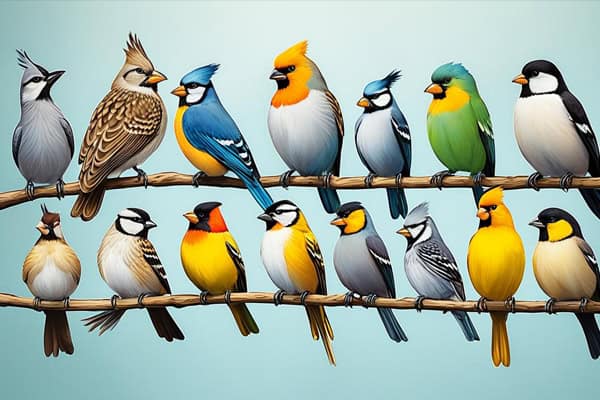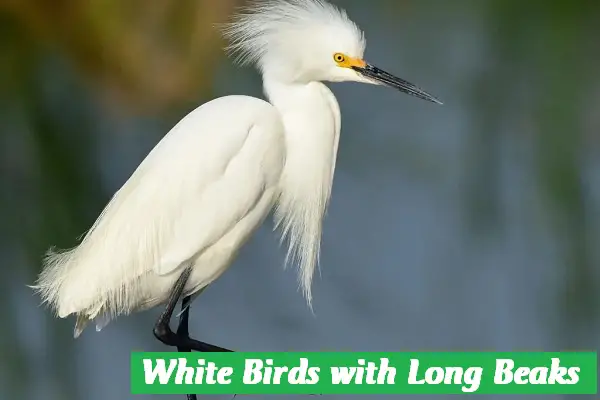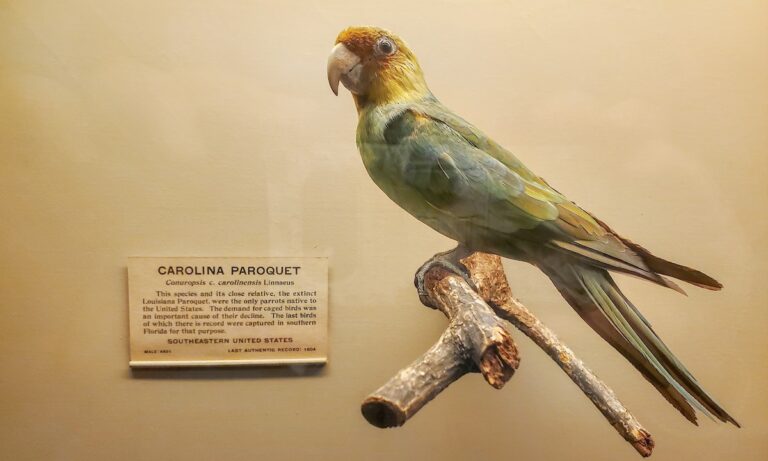5 Types of Hummingbirds in Maryland (With Pictures)
Are you ready to explore the amazing world of Hummingbirds in Maryland? Have you ever seen a bird that looks like a flying jewel, hovering in mid-air with wings beating so fast they’re just a blur? Welcome to the magical world of hummingbirds! These tiny, colorful birds are nature’s own aerial acrobats, zipping through gardens and forests with incredible speed and grace. In Maryland, these fascinating creatures bring joy and wonder to many backyards and natural areas. Let’s explore the enchanting world of hummingbirds and discover the species that call Maryland home, even if just for a short while.
1. Ruby-throated Hummingbirds
- Scientific Name: Archilochus colubris
- Size: 7-9 cm (2.8-3.5 inches) in length
- Weight: 2-6 grams (0.07-0.21 ounces)
- Lifespan: 3-5 years in the wild
- Diet: small insects, and tree sap
The Ruby-throated Hummingbird is the star of the show when it comes to hummingbirds in Maryland. These tiny birds are the most widespread hummingbird species in eastern North America. Males are easily recognized by their bright, iridescent red throats that shine like rubies in the sunlight. Females and young birds have a white throat and belly with green upper parts. Despite their small size, Ruby-throated Hummingbirds are incredible long-distance travelers, flying non-stop across the Gulf of Mexico during their annual migration!
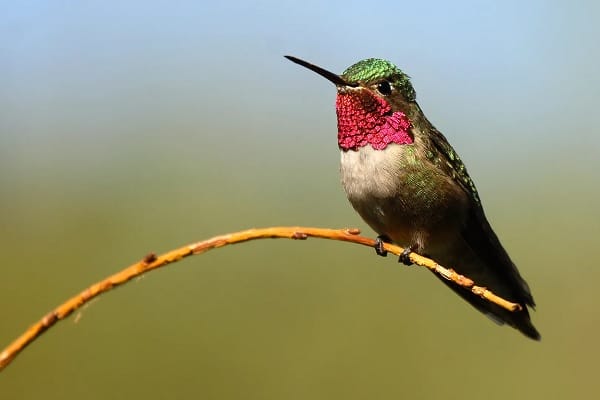
Ruby-throated Hummingbirds are a common sight in Maryland from late April to early October. They’re frequent visitors to gardens, especially those with red, tubular flowers like trumpet honeysuckle or bee balm. These birds play a crucial role in pollination, transferring pollen from flower to flower as they feed on nectar.
2. Black-chinned Hummingbird
- Scientific Name: Archilochus alexandri
- Size: 8-9 cm (3.1-3.5 inches) in length
- Weight: 2.3-4.9 grams (0.08-0.17 ounces)
- Lifespan: Up to 10 years in the wild
- Diet: Nectar from flowers, small insects, and spiders
The Black-chinned Hummingbird is a rare visitor to Maryland, but it’s an exciting sight for any birdwatcher lucky enough to spot one. These hummingbirds are named for the black band under their chin, which can appear velvety black or iridescent purple depending on the light. The males have a thin strip of iridescent purple feathers below this black band, while females lack the flashy throat coloration.
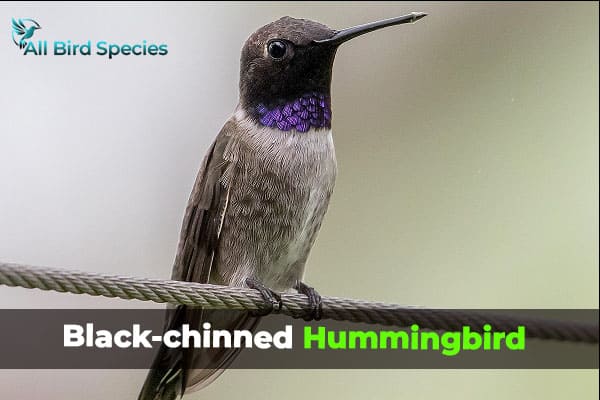
While Black-chinned Hummingbirds are more common in western parts of North America, they occasionally wander eastward, leading to rare sightings in Maryland. These birds are highly adaptable and can be found in a variety of habitats, from desert scrub to urban gardens.
3. Calliope Hummingbird
• Scientific Name: Selasphorus calliope
• Size: 7-8 cm (2.8-3.1 inches) in length
• Weight: 2.3-3.4 grams (0.08-0.12 ounces)
• Lifespan: 3-5 years in the wild
• Diet: Nectar from flowers and small insects
The Calliope Hummingbird is the smallest bird native to North America and Canada, making it a truly tiny wonder. While it’s a rare visitor to Maryland, spotting one of these diminutive birds is a treat for any bird enthusiast. Male Calliope Hummingbirds are known for their striking magenta throat feathers, which form streaks rather than a solid patch. Females are more subtly colored with a pale throat and light cinnamon wash on their sides.

Calliope Hummingbirds typically breed in the mountainous western parts of North America, but they sometimes wander eastward during migration. In Maryland, they’re most likely to be seen in late summer or early fall when they’re moving toward their wintering grounds.
Despite their small size, Calliope Hummingbirds are known for their feisty nature. They’re not afraid to chase away much larger birds from their favorite feeding spots. Their name comes from Calliope, the muse of epic poetry in Greek mythology, perhaps a nod to their outsized personality in such a tiny package.
4. Rufous Hummingbird
- Scientific Name: Selasphorus rufus
- Size: 8-9 cm (3.1-3.5 inches) in length
- Weight: 2-5 grams (0.07-0.18 ounces)
- Lifespan: Up to 8 years in the wild
- Diet: small insects, and tree sap
The Rufous Hummingbird is a feisty little bird known for its bright orange-red coloration and aggressive behavior. While not a common sight in Maryland, these birds are occasionally spotted in the state, especially during fall migration. Male Rufous Hummingbirds are easily identified by their brilliant orange-red throat and rusty-red back and sides. Females have green upper parts and rufous-washed flanks.

Rufous Hummingbirds are known for making one of the longest migratory journeys of any bird in the world, relative to their body size. They breed as far north as Alaska and winter in Mexico, covering an impressive distance for such a tiny creature.
These hummingbirds are famous for their aggressive nature. They’re not afraid to chase away other hummingbirds, and even much larger birds, from their favorite feeding spots. This bold behavior helps them survive in the competitive world of nectar-feeding birds.
5. Anna’s Hummingbird
- Scientific Name: Calypte anna
- Size: 9-10 cm (3.5-4 inches) in length
- Weight: 3-6 grams (0.11-0.21 ounces)
- Lifespan: Up to 8 years in the wild
- Diet: small insects, and tree sap
Anna’s Hummingbird is a stunning bird named after Anna Masséna, Duchess of Rivoli. While it’s primarily a western species, there have been rare sightings in Maryland, much to the delight of local birdwatchers. Male Anna’s Hummingbirds are known for their iridescent reddish-pink throat and crown, which can appear dull brown or sparkling red-pink depending on the light. Females have a small red patch on their throat and are otherwise mostly green and gray.

Anna’s Hummingbirds are unique among North American hummingbirds because they’re largely non-migratory. In their native western range, they stay year-round, even in areas that experience occasional freezing temperatures. This hardiness is part of what allows them to occasionally wander to eastern states like Maryland.
These hummingbirds are known for their elaborate courtship displays. The male will climb up to 130 feet in the air before diving steeply towards the ground. As he pulls up from the dive, he produces a loud chirp with his tail feathers, an impressive sound for such a small bird!
Where to Find Hummingbirds in Maryland
Now that we’ve met the hummingbird species that might visit Maryland, let’s explore where you can find these fascinating creatures:
- Your Own Backyard
- Public Gardens
- State Parks
- Wildlife Refuges
- Nature Centers
Tips for Attracting Hummingbirds:
- Plant the Right Flowers: Hummingbirds are attracted to tubular flowers in bright colors, especially red. Some great choices include trumpet honeysuckle, cardinal flower, bee balm, and columbine.
- Provide Nectar Feeders: Hang hummingbird feeders filled with a solution of four parts water to one part white sugar. Never use honey or artificial sweeteners, as these can be harmful to hummingbirds.
- Create a Water Source: Hummingbirds enjoy flying through fine mists of water. A small fountain or mister can attract them to your yard.
- Avoid Pesticides: Hummingbirds eat small insects as well as nectar. By avoiding pesticides, you’ll ensure a healthy insect population for them to feed on.
- Offer Perches: Hummingbirds need places to rest. Leave small, bare branches on trees or bushes for them to perch on.
Hummingbird Watching Etiquette:
- Keep Your Distance: While it’s tempting to get close to these fascinating birds, it’s important to give them space. Use binoculars for a closer view without disturbing them.
- Be Patient: Hummingbirds can be quick and elusive. Patience is key when trying to spot them.
- Stay Quiet: Loud noises can startle hummingbirds. Try to remain quiet and still when watching them.
- Don’t Use Flash Photography: The bright flash can scare hummingbirds and disrupt their feeding.
- Keep Cats Indoors: Domestic cats are a major threat to hummingbirds and other small birds. Keep your cats indoors, especially during hummingbird season.
Read More🐦Related Articles:
- What is Hobbes Bird?
- Brown Birds In Michigan
- Blue Birds in Michigan
- Yellow Birds in Colorado
- Blue Bird With A Red or Orange Chest
- Bird Beak Types
Final Thoughts
Hummingbirds are truly one of nature’s marvels. Their tiny size, brilliant colors, and incredible flying abilities make them a joy to watch. While the Ruby-throated Hummingbird is the most common species in Maryland, the possibility of spotting a rare visitor like a Black-chinned or Calliope Hummingbird adds excitement to any birdwatching adventure.
By creating hummingbird-friendly spaces in our yards and supporting conservation efforts, we can help ensure that these tiny jewels of the sky continue to brighten our world for generations to come. So keep your eyes peeled and your feeders full – you never know when one of these magical little birds might zip by!



